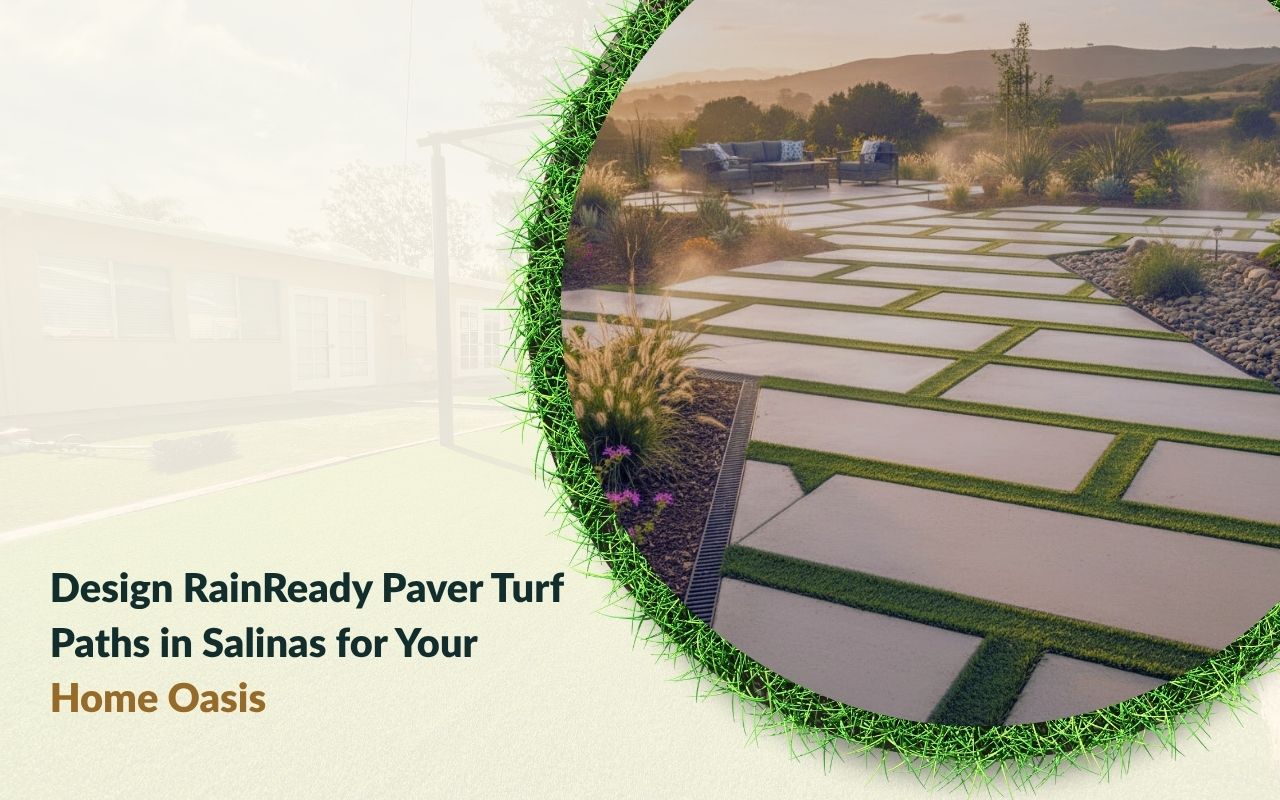
Rain-Ready Paver & Turf Paths in Salinas create a backyard that stays usable, even during heavy storms. By blending pavers, turf, and simple drainage ideas, you prevent puddles and protect your garden soil.
Instead of a muddy mess, your yard becomes a calm space you can enjoy in every season. With the right plan, your paths handle water, support plant health, and still look welcoming and stylish.
Benefits of Rain-Ready Paver & Turf Paths in Salinas
These paths mix firm paver surfaces with soft grass joints, so your yard stays cleaner after rainfall. Water seeps into the ground instead of collecting on top, helping your plants and reducing erosion around your garden beds.
- Less mud and fewer slippery spots after storms
- Better water movement into the soil and root zones
- A neat, landscaped look that feels like a private retreat
- Improved comfort when walking, even with kids and pets
This type of anti-mud walkway plan also creates safer routes across your yard. Firm footing and clear paths mean guests can move confidently, without tracking dirt inside your home.
Planning Your Design Layout
Begin with a simple sketch of your yard that marks trees, beds, slopes, and doors. Decide where Rain-Ready Paver & Turf Paths in Salinas will connect key areas, like your patio, garden seating, and side yard gate.
- Trace natural routes you already walk every week
- Avoid sharp turns; use gentle curves or straight lines
- Keep paths wide enough for two people to walk together
- Note the lowest spots where water tends to collect
Think about how rain flows across your property and away from your home. If your space is compact, explore
small backyard design ideas that pair well with slim paths and cozy seating nooks.
Choosing the Right Pavers for Rain-Ready Paths
Picking durable, attractive materials
Choose permeable pavers designed to let water slip between the joints instead of pooling on top. Concrete, natural stone, and porcelain pavers all work well outside, as long as they are rated for regular moisture and outdoor use.
Match colors and finishes to your home and existing landscape features. Concrete offers many shapes and is easy to replace. Natural stone feels timeless and organic. Porcelain resists stains and cleans quickly, which suits busy households with active families.
Incorporating Permeable Patio Basics
Permeable patio basics start with a solid yet open base of crushed stone or gravel. This layer supports the pavers and encourages water to filter through, limiting runoff and puddles around your yard.
After compacting the base, place a weed barrier that still allows good drainage. Lay your pavers with even gaps, then fill joints using fine gravel or a sand and soil mix. This method locks pieces in place while keeping the system highly absorbent.
Implementing Clever Drainage Solutions
Good drainage under pavers prevents standing water and long-term damage. One helpful choice is a French drain along the side of the path. It uses a gravel-filled trench and a perforated pipe to move water away from your home and planting beds.
You can also hide slim channels between turf and pavers. These channels gather extra runoff and guide it into a gravel trench or dry well. As a result, rain spreads out underground instead of forming slick areas on the surface.
Integrating Turf Between Pavers
Adding turf between pavers softens the look of hard surfaces and makes your path feel more natural. Pick a grass variety that handles Salinas weather, such as drought-tolerant fescue or Bermuda grass. Both options stay attractive with regular trimming and proper watering.
Fill gaps with a thin layer of quality topsoil before placing sod strips or plugs. Keep the grass slightly shorter than your main lawn to avoid overlap on top of the pavers. This detail helps maintain a tidy, effective anti-mud walkway plan.
Ensuring Safety and Accessibility
When you design Rain-Ready Paver & Turf Paths in Salinas, safety should guide every choice. Choose pavers with lightly textured surfaces so shoes grip well, even in wet conditions. Aim for a minimum width of three feet, which makes room for strollers and wheelchairs.
Use gentle slopes that support slow, steady water flow without feeling steep underfoot. Low-profile edging keeps gravel, soil, and turf from spreading over the walking surface. These fall path safety tips help people of all ages move comfortably around your yard.
Enhancing Aesthetics with Greenery
Rain-Ready Paver & Turf Paths in Salinas become even more charming when framed with thoughtful planting. Border edges with evergreen shrubs, low perennials, or ornamental grasses that enjoy slightly moist soil and add color year-round.
Place containers, blooming plants, or small trees at curves, junctions, and entry points to mark special spots. This layered approach softens hard edges and connects your paths to the wider landscape, turning simple routes into memorable garden moments.
Maintenance Tips for Rain-Ready Paths
Routine care keeps your paths working smoothly through many rainy seasons. Sweep leaves and debris off the surface so water can move freely into the joints. Refill washed-out sand or gravel in the gaps whenever you notice low spots.
- Inspect French drains and channels at least once each season
- Remove weeds that push through joints or turf gaps
- Trim grass between pavers to prevent tripping edges
- Reset any pavers that shift, sink, or become uneven
These small tasks protect your drainage system and preserve the path’s clean, finished look. Over time, consistent upkeep supports both safety and curb appeal.
Frequently Asked Questions
How do permeable pavers help during heavy rain?
Permeable pavers allow water to filter through joints into the gravel base and soil below. This reduces puddles, protects plants, and limits runoff that could otherwise cause erosion or flooding around your yard and patio areas.
Can I use turf between pavers in shaded areas?
Yes, but choose a grass type that tolerates shade and damp soil. In deeper shade, consider shade-loving groundcovers instead. They can fill gaps, control mud, and keep your path looking green throughout the year.
What is the best way to start an anti-mud walkway plan?
Begin by spotting where mud forms most often and mapping your main walking routes. Then design paths that follow those routes, add drainage under pavers where needed, and finish with permeable materials that soak up water instead of trapping it.
How often should I maintain my rain-ready paths?
Check your paths at the start of each season. Sweep surfaces, top off joint material, trim grass, and clear drains. Quick, regular checks keep the system working well and prevent small problems from turning into large repairs.
Who can help design a custom path for my yard?
If you want expert guidance, contact a local landscaping team that understands rainfall patterns in Salinas. They can suggest permeable patio basics, layout ideas, and plant choices that fit your property’s size, slope, and style preferences.
Transforming Your Outdoor Space Into a Stunning Oasis
With smart planning and materials, Rain-Ready Paver & Turf Paths in Salinas turn wet problem areas into welcoming walkways. Permeable patio basics, effective drainage under pavers, and well-chosen turf between pavers all work together to control water and support healthy growth.
As you refine your design, an anti-mud walkway plan keeps your yard useful in every season. For tailored ideas that match your property,
contact our Salinas landscaping team and explore how upgraded paths can complete your home oasis.
